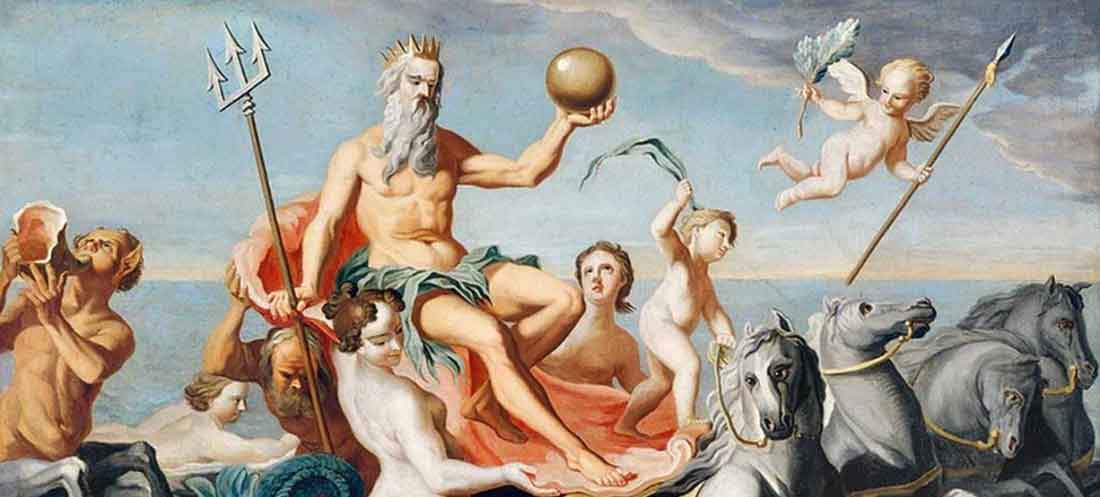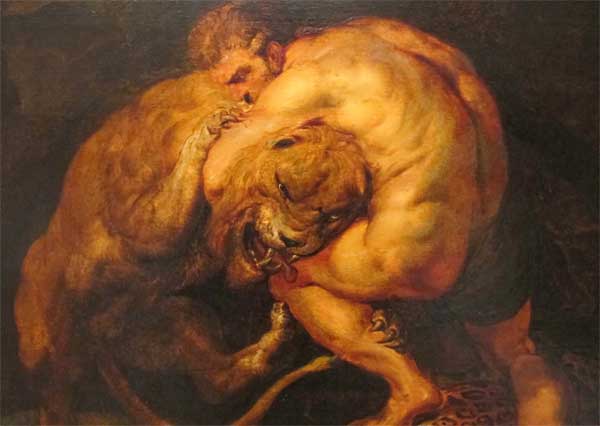Heracles and his Labours
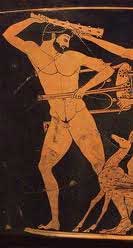
Heracles the famous Greek hero was the son of Zeus and the mortal Alcmena, who the god seduced in the shape of her husband Amphitryon, king of Thebes. He also had a twin brother, Iphicles, who was one night younger then him and was the natural son of Amphitryon. His constant persecutor was Hera, who crazed with jealousy of her husbands liaison with Heracles’ mother caused the hero many troubles.
While Heracles or (Heracles in Latin) was just a baby in the cradle, she sent two snakes which the child strangled, one in each hand. She also made him insane for a while, which made him murder his children with Megara.
Besides these Hera induced frenzies, Heracles was a very brutal character. He killed his music teacher with his lyre in a fit of anger. When he was only eighteen he killed a lion on the mountain Kithairon which decimated the herds of Amphitryon , and for the rest of his life he would carry its skin.
Heracles was the most famous and beloved hero in ancient Greek Mythology, the son of Alcmene and Zeus (typically Amphitryon). The origin of Heracles was from Argos, because he came from the race of the Perseids and from both his parents. But he was born in Thebes, because his father Amphitryonas had taken refuge there when he left Tiryns. Heracles had a twin brother, Iphicles, but not from the same father. Because the real father of Heracles was Zeus and of Iphicles Amphitryon.
Normally Heracles should have become king of Argos, because according to the oracle of Zeus, the first child to be born from the race of the Perseids, would reign in Argos. Then Hera, wanting to avenge Alcmene’s jealousy, sent Eileithyia and delayed the birth of Heracles by a month. At the same time, he accelerated the birth of his uncle Eurystheus by two months. Thus Eurystheas became master of Argos.
When Heracles was still eight months old in his cradle, Hera sent him two huge snakes. The Hero, though a toddler, immediately grabbed them and choked them. As he grew older, he became a large, strong and unruly child. Once he was taking a music lesson and his teacher Linos made a remark to him. Heracles then answered him with a blow so strong that he killed him. Seeing these reactions of his, Amphitryon sent him to Kithairon.
On this mountain the hero lived a shepherd’s life, until he became a man. There he was taught the art of the bow. Later his education was supplemented by illustrious heroes. They taught him the use of all weapons, music, etc. The sophist Prodikos mentions that in this period he was faced with a dilemma: should he follow the path of Virtue or the path of Evil? Heracles preferred the first. So he lived a life full of adventures and struggles, eventually becoming immortal.
On Kithaironas, when he was only eighteen years old, he killed the lion that was plaguing the area. He then freed Thebes from the authority of King Orchomenos, to whom the inhabitants were obliged to pay tribute. As a reward for this service, Creon, king of Thebes, gave him his daughter Megara as his wife. Others say he had three children from her, others eight. But in a moment he was seized with a fit of madness, sent to him by his great enemy Hera, and killed his wife and children. When he came to his senses and realized what he had done, he wanted to purify himself and went to the oracle of Delphi to ask in what way. Pythia advised him to serve his uncle Eurystheus for twelve years. Thus he accomplished his famous twelve feats in a period of eight years and one month. At the same time, however, he did other feat

The evil one suggested him to follow the easy path, wide and straight where he will enjoy life and wealth, but he would be commit iniquities and injustices. Heracles eventually followed the path of Virtue that gave him glory and recognition for his good deeds.
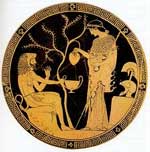
There are many stories about Heracles. Thanks to him the gods defeated the giants, since they could only beat them if a mortal would fight with them. As a youth he defeated the enemies of Thebes, and as a reward king Creon of Thebes gave him his daughter Megara. His constant follower was Iolaus, who was also his nephew.
The twelve labours of Heracles
Growing up, his power became mythical, no one could compare to him. But Heracles despite his strength, decided to follow a quite life. He married and had three children. Unfortunately Hera, who always hated him, seeing his family happiness, clouded his mind forcing him to kill his wife and children.
When Heracles realized what he had done, he could not calm down from anger and remorse. He decided to visit the Oracle of Delphi and ask Pythia what he had to do to make peace with his soul.
Pythia replied that he had to serve for twelve years his cousin king Eurystheus of Mycenae and to do whatever the king told him. Only then would he expel the burden from his soul. The feats he had to face were: to kill the lion of Nemea, to kill Lernaean Hydra, to catch the fast deer of Kyrenia, to kill Erymanthios Kapros, to clear the stables of King Augeias, to kill the Stymphalides Hens, to catch the wild bull of Crete, to steal the wild horses of Diomedes, to take the belt of Hippolytus, to take the apples of Hesperides and to bring Cerberus from Hades.
The tasks of the mythical hero Heracles who made in order to purify himself for the murder of his wife and children (which he had committed when Hera drove him crazy) have been recorded in Greek mythology as the labors of Heracles. For this purpose, the Greek hero went to the Oracle of Delphi and received an oracle, according to which he had to serve for twelve years Eurystheus, king of Tiryns, and perform the labors that he commanded.
The Nemean lion
The first labour was to kill the Nemean lion, which he did with his bare hands. This frightened the king so much that he would not let Heracles inside Mycenae walls, the hero had to show his trophy outside the walls.
The Nemean Lion lived in the Nemean region and spread fear and terror, devouring animals and people. He was the offspring of Typhon and Echidna or Orthros and Chimaera. Another version states that it fell from the Moon, who threw it to the earth and was the offspring of Zeus and the Moon.
The lion’s skin was impervious to his arrows and fireproof. Herakles managed with the divine power of his hands to suffocate it and only with the animal’s teeth was he able to remove its skin.
From then on Herakles wore the lion’s skin as impenetrable armor. When Eurystheus saw Heracles with the lioness, he hid in fear in a jar, thinking that the lion was alive and would eat him.
As soon as he got over his terror he decided to assign even more difficult tasks to Herakles.
The Lernaean hydra
The second labour was to fight the Lernea Hydra, an immortal monster with nine heads. It was a terrible snake with nine heads that lived near Argos and Tiryns, in a lake called Lerna. The ancient Greeks believed that this lake bordered Hades. The inhabitants of the area did not dare to face the dangerous water snake because they said that it was also a child of Echidna and a sister of the Nemean lion and that if they cut off one of its heads, two more would grow in its place.
Heracles took with him his beloved nephew, Iolaus, who was the son of his brother Iphicles. With Iolaus they lit a big fire to lure the monster out of its hiding place. Heracles began to cut off the heads of the Lernaean Hydra with his ax, and Iolaus burned the neck with a lighted torch so that two more would not grow in their place.
Only the middle head remained which was larger and immortal. Herakles also cut it down, buried it deep in the earth so that it would not come to life and come to the surface. He then dipped his arrows in the blood of the Lernaean Hydra, which was poisonous thus making his arrows even more deadly.
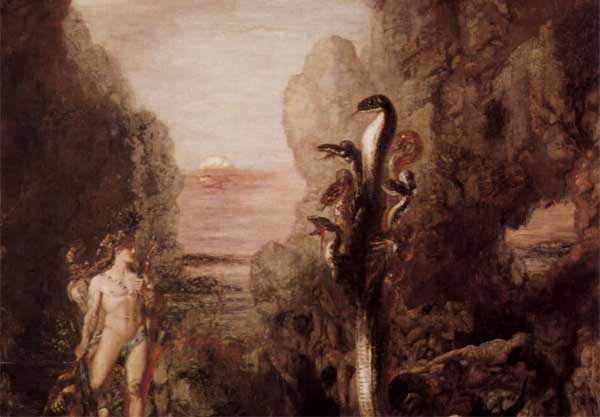
The Ceryneian Hind
The third labor of Heracles was to bring alive to Mycenae the Ceryneian hind with golden horns and silver hooves, a favorite animal of the goddess Artemis. The deer was grazing on Mount Artemisium, a distance of fifty miles from Mycenae.
For a whole year, Heracles tried to capture the animal, but his efforts were unsuccessful. In the end he managed to catch it with his bow near a stream. The rage of the patroness Artemis was to be expected, but she was reassured when Heracles explained to her the reason why he was hunting and finally wounded the animal and so the goddess allowed him to take the deer to Mycenae.
The Ceryneian hind had bronze legs and golden horns. It was fast and unruly. Heracles did not kill the deer, since the king had not asked him to do so. However, he had to find a trick to accomplish his task and not anger Artemis. He caught it, took it to Eurystheus and asked him to come out of the palace and get the deer himself. When Eurystheus tried to catch it, Heracles let it go and the deer escaped, running quickly towards its patron goddess.
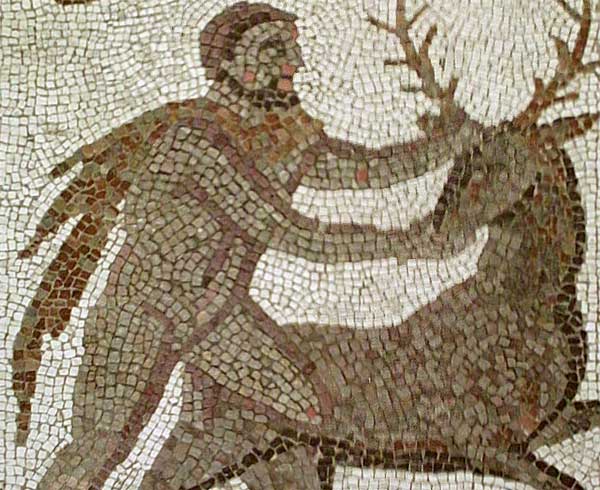
The Erymanthian boar
The fourth labour was the capture of a terrible wild boar, The Erymanthian boar which lived on the mountain Erymanthos in North Arcadia.
Erymanthos is a mountain located on the border of Arcadia and Ilia. In those parts lived a terrible wild boar known by the name “The Boar of Erymanthos”. It was huge, with terrible tusks and it destroyed the crops of the farmers. Not even the Centaurs could face it when it descended for food in the forest of Foloi and for water in the gorge.
Eurystheus wanted this boar alive, which meant that Herakles would have to fight it.
A centaur, named Pholos, gladly accepted to host Herakles in his cave. But when they opened a pitcher of wine and began to drink, the other centaurs heard about it and ran to drink too. The rest of the Centaurs were not as civilized as Folos. In their anger, that there was not enough wine for everyone, they decided to kill Folos and Heracles. Then a fierce battle began between them. Herakles managed to crush the centaurs, but in the battle he accidentally killed his friend Pholos with an arrow poisoned by the blood of the Hydra.
The next day he buried his friend with honors and searched for the terrible boar. When he found the animal he managed to capture it with a rope. He tied it and carried it on his back to Eurystheus.
At that time, Herakles is said to have taken part in the Argonautic expedition, in which most of the heroes of the time had participated, led by Jason. But because the divine weight of Herakles was delaying the sailing of Argos, his companions abandoned him in Asia Minor. Another myth says that on the shores of Mysia Hylas, a friend of Herakles, went out to find water. He came across a spring, but there he was lured by the water nymphs into the depth of the spring. Herakles was inconsolable and began to search everywhere to find him. But unfairly. The Argonauts were forced to abandon the hero and continue their journey without him.
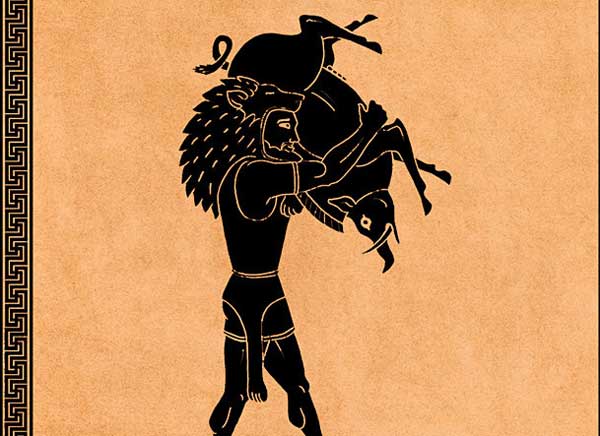
King Augeas stables
The fifth labour was to clean king Augeas’ stables in Elia on the Peloponnese. The stable was huge and full of dung, and Heracles cleaned it by leading two rivers into it.
Augeas reigned in Ilia, located on the west coast of the Peloponnese. They said of him that he was the son of the Sun and that his eyes shone as the rays of the Sun shine in the morning. Augeas owned many herds of oxen, which he locked in a large stable at night. Little by little this stable was filled with manure. Eurystheus asked Heracles to clean up the dung in a single day.
Herakles noticed that these hideous stables were located between two rushing rivers, the Alpheus and the Pineus. He then began to dig a wide furrow from Alpheus and brought it to one entrance of the stable. He did the same with Pinios. The second furrow reached another stable entrance. The rushing waters of the two rivers united inside the stable and… within a few hours they carried away all the manure. So even before Helios reigned, King Augeas found Herakles waiting for him in a spotless stable, where there was no trace of dung.
Augeas had made a bet that if Heracles succeeded in his feat, he would give him a tenth of his herds, which he did not keep. Herakles then campaigned against him and even killed him and all his sons, except Phyleas who had supported him.
During his campaign she killed both Molions, twin monsters who together had one body with two heads. After this feat, his campaign to Sparta or Lacedaemon is mentioned. There he punished the twelve sons of Hippocoon and restored Tyndareus to the throne.
On the way to Lacedaemon, he met Avgi who was the daughter of the king of Tegea Aleus. Heracles fell in love with her and made her the mother of Telephos. During the same period he also killed the centaur Eurytionas, because he claimed Mnisimache, daughter of Dexamenos, king of Olenos.
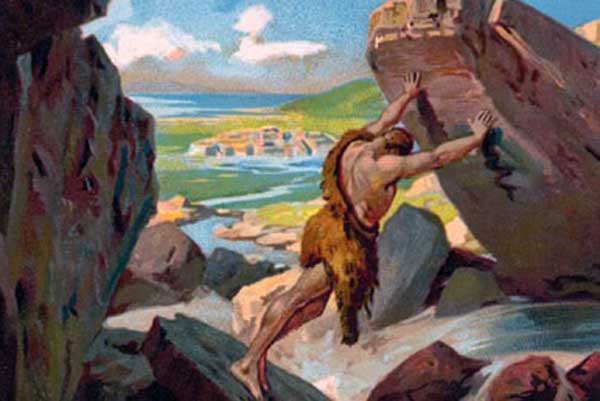
Stymphalian birds
On the northeastern border of the prefecture of Arcadia was a lake. It was called the lake of Stymphalos. There, among the thick trees of the bank and the bushes, lived some strange and dangerous birds that the inhabitants called Stymphalid Hens. They had bronze pointed wings and beaks. And their claws were bronze, long and pointed, and these hens fed on human flesh.
The Stymphalian hens were chased by wolves through a ravine near Orchomenos in Arcadia and had taken refuge in Lake Stymphalia in mountainous Corinthia, posing a threat to people, flocks and crops. Heracles did not know how to make them come out of the thick vegetation of the lake. Then the goddess Athena appeared to him as a machine god, who gave him copper rattles forged in the workshop of Hephaestus, which the hero rattled from a hill by the lake. With these sounds the birds rose up in terror and Heracles exterminated them with his arrows.
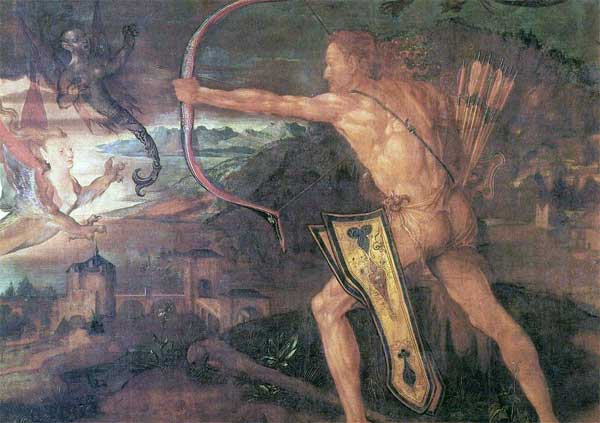
The Cretan bull
The seventh labour was to capture the Cretan bull, which either was the father of the Minotaur or the bull that had taken Europa on its back. Heracles brought it to Mycenae, but let it go, and it wandered off to Attica where Theseus later had to fight it.
This bull was a huge animal that came into the world after a wish from the king of Crete, Minos. Specifically, Minos promised Poseidon that he would sacrifice to him anything that came out of the sea. Then, a majestic bull emerged from the sea, but Minos, enraptured by the animal’s beauty, sacrificed another animal in its place, thinking it would trick the god.
Poseidon was enraged and infuriated the bull, which began to wreak havoc on the island. According to a different version of the myth, Poseidon made Pasiphae, wife of Minos, fall in love with the bull. From their union was born the Minotaur.
In any case, the labor that Heracles was called upon to perform was to bring Eurystheus that bull from the kingdom of Minos in Crete.
Herakles ambushed the bull and when he saw it emerge from behind the foliage above him, he shook his rope and managed to noose the bull’s head and one foreleg. When the wild animal fell down, he struck it on the head with his club, stunned it, and thus tied it up in peace. He then carried it on his shoulders and loaded it into a ship for Tiryns.
Eurystheus later released the bull. He stayed for a while in the Peloponnese and passing through the Isthmus of Corinth reached Attica, in the region of Marathon. He began to spread fear and death again, until another hero, Theseus, took it upon himself to kill him.
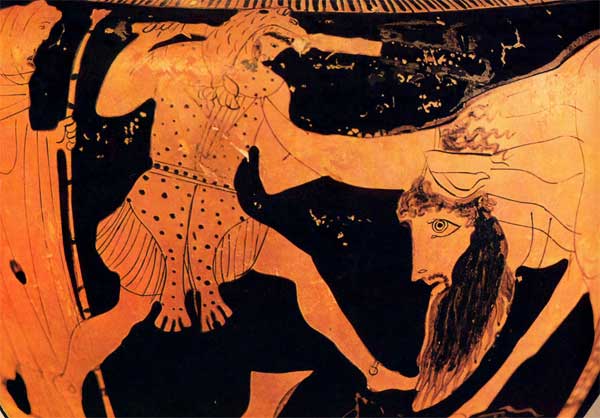
The Mares of Diomedes
The eight labour was to capture the man eating horses of king Diomedes of Thrace. Heracles killed the king and captured the horses, and founded the city Avdera.
Diomedes was king of Thrace and son of the god Ares. Ares had given him four horses that ate people instead of grass! It was even said that every stranger who arrived at his palace, Diomedes threw food to his horses. These terrible horses were to be taken by Heracles, since he would first face Diomedes and bring them from Thrace to the Peloponnese.
After resting enough in the palace of Admetus, he continued his journey to Thrace. He arrived at the palace of Diomedes and he received him willingly. He did not know who the stranger was and intended to throw him into the mangers of his wild horses to satisfy their hunger. But Heracles guessed his purpose and when Diomedes’ warriors rushed to kill him, he managed to defeat them.
Then Diomedes rushed to kill his stranger. He was fierce like his father Ares and terribly cruel. He came to arms with Heracles and they fought furiously for some time. In the end, while they had fought their way to the stable where the wild horses were tied, Heracles managed to defeat Admetus. He then threw him in front of his horses who immediately devoured him. Thus Diomedes was severely punished for what he had done to his foreigners. He met the same death.
When Heracles arrived at the palace, Admetus had been healed and was standing, while Alceste was dying. Then Heracles, moved by Alceste’s sacrifice, decided to save her. He entered her room alone, and when he saw Death, who was about to take her soul, he rushed upon him, they came to arms, and after a fierce struggle he succeeded in defeating him and saving the beautiful queen.
When the horses had had enough of Diomedes, Heracles easily tamed and tied them. He then took them out bound with their heavy chains and took them to the Peloponnese. The wild horses were slowly domesticated and their breed reached the time of Great Alexander. It is even said that Bucephalas was from the race of Diomedes’ horses.
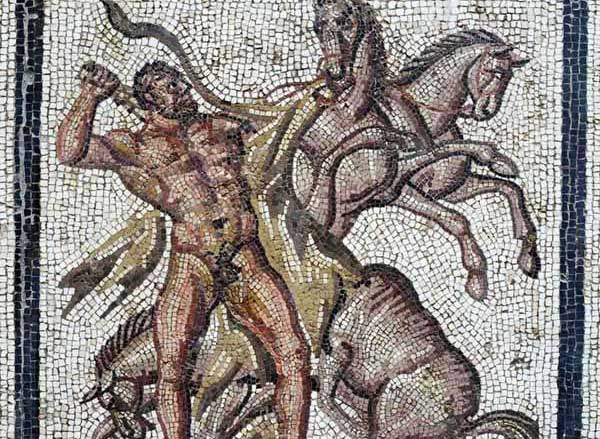
The girdle of the Hyppolyta
The ninth labour was to get the girdle of the Amazon queen Hippolyte (Hyppolyta). He either defeated her or she gave it to him willingly.
In distant Pontus lived a tribe of Amazons. They were all beautiful women, but fierce and proud warriors. They were excellent horsewomen and famous in the art of archery. Their queen was called Hippolyte, or according to another version Melanippi, and she was easily distinguished from the others because she wore an all-gold belt, an emblem of her power. They said that she was the daughter of the god Ares and that her father gave her the belt for her bravery in battle.
Admit, daughter of Eurystheus, wished to obtain this girdle, which is why Eurystheus commissioned Heracles to bring it to him. On this journey, Heracles took with him some other famous heroes of the time: Theseus, Peleus and Telamon.
On their journey to the Black Sea they encountered, as expected, several adventures. In Paros, the wild moods of the island’s inhabitants drove them to kill two companions of Heracles. The hero then enraged killed the four children of Minos who lived on the island and besieged the inhabitants of the island within the walls of the city. They, not withstanding the siege, were forced to capitulate with Heracles and replace his two dead companions with Sthenelus and Alkaios, grandsons of Minos. In Mysia, the Wolf king was at war with a neighboring tribe. Heracles helped him to defeat his enemies and he, to honor him, named the country he conquered Heraclea.
Finally, when Heracles and his companions arrived in the country of the Amazons, Hippolyte, seeing them, initially appeared willing to hand over her belt. Hera, then disguised as an Amazon, incited the rest of the Amazons who considered Heracles’ demand an insult and rushed to kill him. During the battle many Amazons were killed including Hippolyte. Heracles thus took the queen’s golden girdle, while Theseus also took with him one of the Amazons named Antiope. From the marriage of Theseus with Antiope, Hippolytus was born.
On the way back, Heracles passed through Troy. There he saved King Laomedon’s daughter, Isione, from a sea monster sent by Poseidon to punish the king. Laomedon had built the city walls with the help of Apollo and Poseidon, but refused to repay the two gods. In response, Apollo sent a plague to the kingdom, while Poseidon sent the sea monster.
As a reward for Heracles saving Hesione, Laomedon had given him the horses of Zeus that he had in his possession, but in the end he did not hand them over. Heracles for revenge besieged and conquered Troy. Hippolyta’s girdle ended up in the hands of Eurystheus’ daughter.
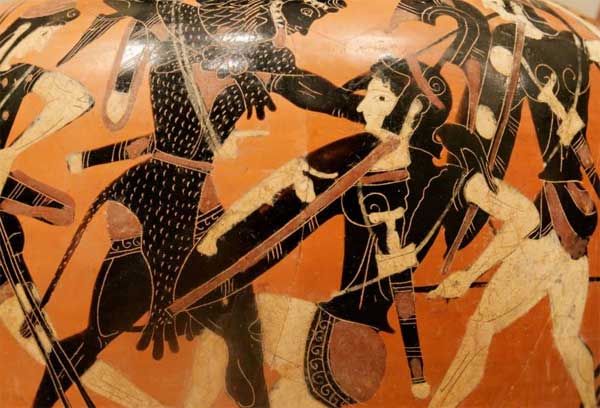
The herd of the giant Geryon
The tenth labour was to bring back the herd of the giant Geryon on the island Erytheia. On his way to this western place by Oceanos, he made a passage through the Atlas mountains, setting up the pillars of Heracles – today’s Gibraltar. He made it to the island in the cup of the sungod, and killed Gerion and his dog Orthros. The herd he brought with him back to Greece.
For the tenth labor Heracles had to go far to the west, where there was a country inhabited by a monstrous man, Geryon. Geryon had two legs but from the waist up he split into three people. That is, he had three trunks, three heads and six arms.
Geryonis had a famous herd of red oxen, large and fat, the like of which were not found anywhere in the world. His flock, apart from himself, was guarded by his faithful shepherd Eurytionas, who was also a giant and a monstrous dog, with two heads, who was called Orthros and was the son of Typhon and Echidna. Heracles, therefore, following Eurystheus’ command, had to go to Geryon’s country and bring them to Tiryns.
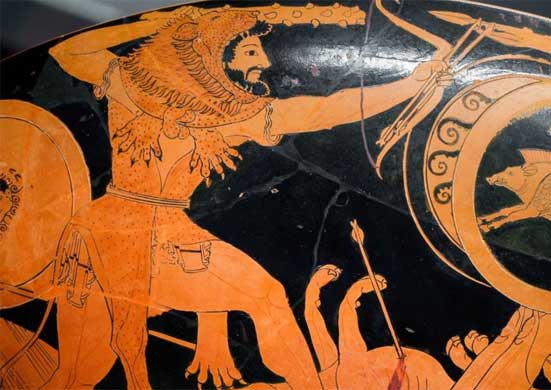
Tthe golden apples of the Hesperides.
The eleventh labour was to bring back the golden apples of the Hesperides. According to one version he killed the dragon that guarded the apples and took them. According to another he went to Atlas, the father of the Hesperides. Heracles took the sky on his shoulders while Atlas went to get the apples, but when he returned he did not want to take over the burden of the sky again. Heracles then told him to hold the sky only for a short moment while he put a pillow on his shoulders, and so tricked Atlas into taking his position again.
In the distant land of Atlas, Hera had planted in the garden of the gods some magical apple trees, which made golden apples. The apple trees that produced these fruits were given by Earth to Zeus and Hera as a wedding gift. In this garden lived some nymphs, the Hesperides, and only they could cut the golden apples. To prevent anyone from approaching this unique tree, it was guarded day and night by a serpent with a hundred heads, Ladon, son of Typhon and Echidna. Eurystheus asked Heracles for these apples as his eleventh labor.
As Herakles advanced towards the land of the Hesperides, he reached the Caucasus. On this mountain Zeus had chained Prometheus to punish him for stealing fire from the gods and giving it to humans. A vulture came every day and ate his liver, which in the evenings grew anew in his body, as Prometheus was immortal. Heracles, moved by the martyrdom of Prometheus, killed the eagle with one of his arrows and freed the benefactor of mankind from his chains. Prometheus thanked him for saving him and asked him where he was going. Herakles then explained to him that he was going to steal the apples of the Hesperides. Prometheus then advised him to ask Atlas who was near the garden and held the sky, to take his place for a while so that he could bring him the apples.
So it happened. Herakles avoided entering the garden protected by Hera. He asked Atlas to hold the impenetrable sky for a while so that he could bring him the apples. Atlas accepted, went to the garden, killed the dragon and returned with the golden apples of the Hesperides. But Atlas had been freed from the torment of heaven, and appeared unwilling to return to his post. He told Herakles that he himself would take the apples to Eurystheus. Herakles who understood that Atlas had no intention of taking the sky on his shoulders. He asked him to show him the proper way to hold the firmament. Unsuspecting, Atlas put down the apples and held the sky to show Herakles how he should lift it. Then Herakles grabbed
the apples and ran away, tricking Atlas.
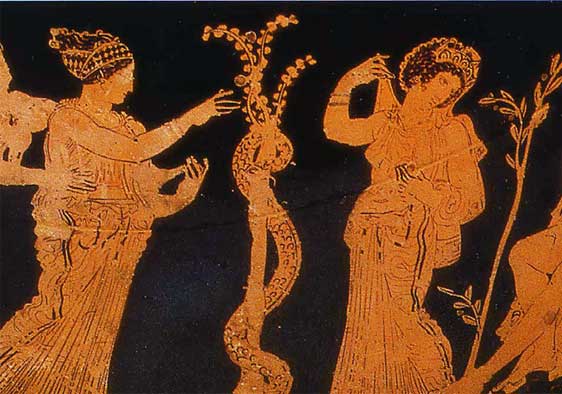
Cerberus
The twelfth, and final, labour was to bring back the three headed dog Cerberus, which guarded Hades, which he did. Cerberus was son of Typhon and Echidna, who had brothers the two headed Orthrus, the dog of Geryon and the Hydra.
Other Labours of Heracles
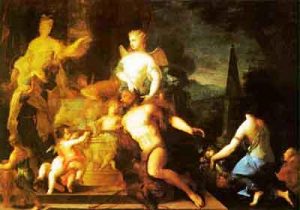
When Heracles later wore it, the centaur’s blood turned out to be poison, and he could not get it off, slowly poisoning him to death and causing him great pain. Heracles then climbed the funeral pyre and was deified, marrying the Godesses Hebe on Mt. Olympus.
There are many more stories about Heracles. He was one of the Argonauts for short while, during the campaign he liberated Isioni , the daughter of King Laomedon by a sea monster. However, he did not follow the end of the campaign because he was too heavy and the Argo, the ship of the Argonauts, could not withstand his weight.
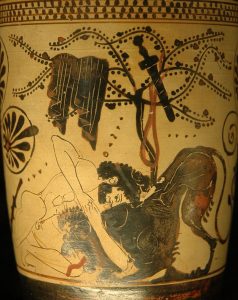
The goddess Athena on many occasions expressed her favour towards him. Heracles often used Nereus help, who gave him the goblet of the sun to cross the ocean, and showed him the path to be followed in order to to reach the garden of the Hesperides.
Literary sources and art complement the information we have about the hero. Of course, it is not expected that all writers and all artists deliver in exactly the same way the action and ethos of Heracles. For example,
Euripides considers that the madness of Heracles, which led him to the murder of his first wife and their children, took place at the end of the 12 labours, while the tradition wants these murders as a cause for the slave service to Eurystheus and the performance of the deeds as purification by them.
However, poetic imagination and artistic creation are intertwined with a reality and a historicity, which unfolds the myth starting from Argos and the Peloponnese, the place of origin of the hero, to more and more remote areas.
Of course, the myth crystallized as a whole and not in the stages of its creation. But again only the childhood of the hero, his upbringing, death and apotheosis can be entered in an elementary chronological order. The clarifications inserted are intended to function as a thread in the adventures of Heracles life.
Heracles after the twelve Labors
When Heracles had completed his twelve labors, he returned to Thebes. He then went to Oichalia in Thessaly. King Eurytos reigned in this country, who had a beautiful daughter, Ioli. Eurytus had proclaimed that he would give his daughter as wife to whoever defeated him and his sons in the archery. Heracles won, but Eurytus refused to keep his promise.
Then the hero killed Iphitus, the king’s son. Then he asked Nileas, king of Pylos, to purify him of this murder. Because he refused, Heracles killed him, as well as all his sons, only Nestor escaped, who was absent in Sparta. Because of Iphitus’ murder, the hero went mad a second time. So he went to seek the advice of the oracle of Delphi.
Pythia refused to mount the tripod and give an oracle. Heracles then grabbed the tripod with the intention of taking it and going elsewhere, to establish his own oracle. Apollo, who was worshiped at Delphi, tried to get the tripod back. A clash between the god and the hero almost ensued. She was stopped by Zeus, throwing a thunderbolt.
The two rivals reconciled and Apollo gave Heracles an oracle related to his purification. That is, he told him to be sold as a slave for three years. The money he would receive, he had to give to Eurytos, as compensation for the death of his son. In this way he would be cured of his madness.
Thus Heracles was sold to the queen of Lydia, Omphalis. The ancient Greeks say that during this period he accomplished many feats:
He punished the Kerkopians who were a people of dwarf robbers. In Lydia he killed the robber Syleas and the daughter of Xenodokis. He threw into the Maiander river the bloodthirsty Lityerses, who was the illegitimate son of the Phrygian king Midas. In Aetolia and Trachinia, located at the foot of Oita, Heracles had the last adventures of his life.
The death of Heracles
In the twelfth labor of Heracles, we saw that once Heracles reached the gates of Hades, he met Meleager, who asked him for a huge favor. His sister, Deianeira, was left alone in the upper world, since Meleager was dead. Heracles gave him his word that he would marry his sister. After completing the task and handing over Cerberus to Eurystheus, Heracles had to keep his word. So he sought Deianeira, daughter of Oeneas, and married her. Together they had four children, three boys and a daughter, most famously his son, Yllos.
Heracles’ family traveled to meet Meleager, but on their way, they came face to face with the river Acheloos, who also wanted Deianeira by his side. The two personalities battled with Heracles adding another victory to his repertoire. They then continued on their way facing yet another threat. In the river Evinos he found himself with the Centaur Nessus, a centaur who helped people cross the river by carrying them on his shoulders, in exchange for money.
Heracles kills the Centaur Nessus. Black figure, which is found on the neck of an Attic amphora. The artist has been named by the researchers “Painter of Nessos”. Image source: upload.wikimedia.org
Heracles, of course, crossed the river alone. Deianeira immediately climbed onto Nessus’ shoulders and began to cross the river. Nessos, enchanted by her beauty, fell in love with her and wanted to keep her close to him. But this was not to happen, since she was betrothed to Heracles and had built her own family. He even tried to abuse her, but in vain, because as soon as Heracles realized the fact, he raised his arrow and shot him. Shortly before Nessus died, he gave Deianeira his blood and ordered her to anoint his tunic with it. Thus, Heracles would always remain in love with his wife and would not love any other woman.
When Heracles happened to leave with his son for a long journey, his wife smeared Heracles’ tunic with the blood of Nessus, believing that this way no one would steal her husband. As Heracles and Hyllos were walking, he suddenly felt a chill in the atmosphere and put on his tunic. However, from the moment he did so, wounds filled his entire body and burned him like fire. No matter how hard he tried to pull the cloak off, it wouldn’t come off. So he thought of gathering wood and lighting a fire to burn. No one was helping him. Only his friend Philoctetes lit his fire and then a huge cloud of lightning appeared and took Heracles into the sky. It was time to become immortal. He reconciled with Hera, met Athena, and lived a life of honor, sacrifice, and ceremony in his honor, away from mortal men.
